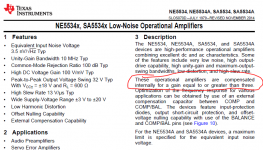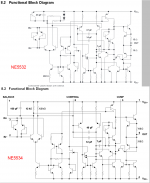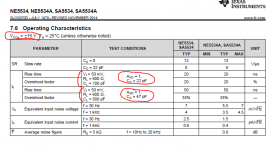@benb:
Good info, thank you. I'll be sure to "bang on it" when I mock up something new now. 🙂
@Michael Bean:
For now I am going to use the 5534 for an inverting buffer which will be fed an adjustable EQ'd signal similar to the graph in post #6. But I have a few more of these chips which I'll no doubt end up using in future projects so if anyone has any advice, it's welcome.
For example, it seems like 5 is the magic number for not needing a compensation capacitor? This is going by a search from Benb's advice in post #4: http://www.diyaudio.com/forums/solid-state/73827-ne5534-compensation.html
MBean, you say a gain greater than 3 needs no compensation in post #3. Where are you guys seeing this in the datasheet?
Good info, thank you. I'll be sure to "bang on it" when I mock up something new now. 🙂
@Michael Bean:
For now I am going to use the 5534 for an inverting buffer which will be fed an adjustable EQ'd signal similar to the graph in post #6. But I have a few more of these chips which I'll no doubt end up using in future projects so if anyone has any advice, it's welcome.
For example, it seems like 5 is the magic number for not needing a compensation capacitor? This is going by a search from Benb's advice in post #4: http://www.diyaudio.com/forums/solid-state/73827-ne5534-compensation.html
MBean, you say a gain greater than 3 needs no compensation in post #3. Where are you guys seeing this in the datasheet?
Oops. Yeah I did read that, I'm clearly losing my mind. So where does it tell you what to use with gains of <3?
The 5532's datasheet says that it is compensated internally for unity gain. Looking at the layout there is only a difference of 37-40pF and 14-12pF. Is this where they are compensating? Does this mean that the 5532 becomes unstable with gains of over 3?
Attachments
The 5532's datasheet says that it is compensated internally for unity gain. Looking at the layout there is only a difference of 37-40pF and 14-12pF. Is this where they are compensating? Does this mean that the 5532 becomes unstable with gains of over 3?
No, as it states, it's stable for gains of unity and above for non-inverting as well as inverting topologies.
So I'm curious as to why you're fixated on using the 5543 in that circuit? It really would make more sense to use one that is inherently unity gain stable, like the 5532 for example.
Mike
I just need a single and I have a bunch of these 5534's to use up so I figured I will try to learn as much as I can about them so I can start using them when I need a single. They look to be quieter than the 32's too which is always a plus.
here is one place in the datasheet where some guidance (as in recommended values) is given. there's probably others; i didn't look past page 6.
i assume you want unity gain? i haven't kept up with this thread to see if you looking for some gain that is >1 but <3.
these will get you close; then you add your DIY magic.
aka, play with it.
😉
mlloyd1
i assume you want unity gain? i haven't kept up with this thread to see if you looking for some gain that is >1 but <3.
these will get you close; then you add your DIY magic.
aka, play with it.
😉
mlloyd1
Oops. Yeah I did read that, I'm clearly losing my mind. So where does it tell you what to use with gains of <3?
Attachments
This is what Douglas Self used for a compensating capacitor in his RIAA preamp. RIAA preamps have to be unity gain stable.
http://www.markhennessy.co.uk/preamp/Phono.pdf
http://www.markhennessy.co.uk/preamp/Phono.pdf
Sounds interesting - the trusty 5534 really is quite tweakable, I must say. Is the article available anywhere without signing up for anything?the 5534 can even be 2-pole compensated for unity gain, keeping the higher open loop gain for lower frequencies - Bruce Hofer gave a circuit in his master class notes
the AP site does want your info - but I only see a few emails a month on their seminars/new product
The Stanton 310 RIAA preamp uses the NE5533, which appears to be two 5534s in a 16 pin package, and doesn't use any compensation capacitor. However the output amplifier using the NE5533 does use a compensating capacitor.
http://www.technicalaudio.com/pdf/Stanton/Stanton_310_phono_preamp_user_book.pdf
http://www.technicalaudio.com/pdf/Stanton/Stanton_310_phono_preamp_user_book.pdf
NE5534 Compensation Cap Test...
I got around to testing the NE5534 with no compensation cap vs. with a couple different values of CC in stability and distortion. I wired up an NE5534 on a breadboard as a non-inverting unity gain buffer. I looped my computer's soundcard from in to out and used it as a baseline for the following measurements.
I did not notice any noteworthy increase in distortion numbers, change in frequency response or instability for the NE5534 with no compensation capacitor, using 10pF or 20pF. The only thing that I noticed was that the NE5534's noise floor was improved by almost 10dB with local decoupling caps (220uF) and that with plus/minus 15.22V rails feeding the chip, when there was nothing connected to it's input, the output went to -13.9V DC. In all configurations the chip remained stable even though it was at unity gain and it's noise floor was consistent.
Here are the frequency response measurements from 2-20kHz. There was no difference in level or response for any of the configurations.

I picked 2 frequencies to test distortion numbers; 20Hz and 1kHz. This is the soundcard's THD at those 2 frequencies:

This is the NE5534 with no compensation capacitor:

This is the NE5534 with 10pF as the compensation capacitor:

This is the NE5534 with 20pF as the compensation capacitor:

These are distortion sweeps showing THD levels from 10Hz to 10kHz for all configurations:

I got around to testing the NE5534 with no compensation cap vs. with a couple different values of CC in stability and distortion. I wired up an NE5534 on a breadboard as a non-inverting unity gain buffer. I looped my computer's soundcard from in to out and used it as a baseline for the following measurements.
I did not notice any noteworthy increase in distortion numbers, change in frequency response or instability for the NE5534 with no compensation capacitor, using 10pF or 20pF. The only thing that I noticed was that the NE5534's noise floor was improved by almost 10dB with local decoupling caps (220uF) and that with plus/minus 15.22V rails feeding the chip, when there was nothing connected to it's input, the output went to -13.9V DC. In all configurations the chip remained stable even though it was at unity gain and it's noise floor was consistent.
Here are the frequency response measurements from 2-20kHz. There was no difference in level or response for any of the configurations.

I picked 2 frequencies to test distortion numbers; 20Hz and 1kHz. This is the soundcard's THD at those 2 frequencies:

This is the NE5534 with no compensation capacitor:

This is the NE5534 with 10pF as the compensation capacitor:

This is the NE5534 with 20pF as the compensation capacitor:

These are distortion sweeps showing THD levels from 10Hz to 10kHz for all configurations:

Last edited:
- Status
- Not open for further replies.
- Home
- Source & Line
- Analog Line Level
- External compensation capacitor value for NE5534 op amp...


